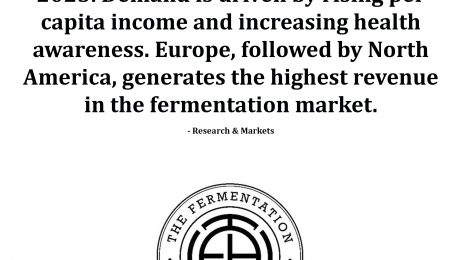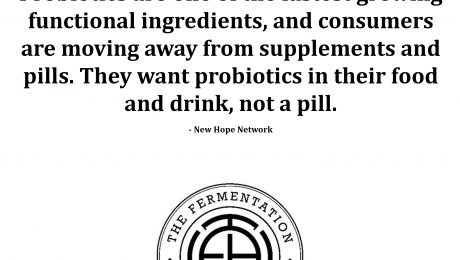Fermentation Market Projected to Reach $689.34 Billion by 2023
The fermented food and ingredient market is projected to reach $689.34 billion by 2023. Demand is driven by rising per capita income and increasing health awareness. Europe, followed by North America, generates the highest revenue in the fermentation market.
- Published in Business
Scientists Find Cell Receptor Unique to Humans that Responds to Fermented Foods
Though studies link fermentation to positive health benefits, little is known about the underlying biology behind why consuming the live bacteria in fermented food and drink is good for your gut. Scientists from Germany have uncovered that link. They found a cell receptor unique to humans (and apes) that binds to the lactic acid bacteria in fermented foods, triggering positive effects in the immune system. The study says the bacteria or microbes are part of a large group of “functional microorganisms” that are present in food like yogurt and sauerkraut.
Read more (Medical News Today)
- Published in Science
As Consumer Distrust in Probiotic Pills Grows, Fermentation Brands Need to Educate on Benefits of Live Bacteria
Probiotic supplements have been the hype of the health industry for the past few years, but the rage is dissipating. Consumers are starting to distrust probiotic pills, realizing a pill alone doesn’t deliver on promised health benefits.
“The thing is, you can’t just pop in a probiotic and get better health,” said Ashley Koff, a registered dietician and CEO of the Better Nutrition Program. “Consumers are waking up to the fact that our digestive health is more complicated than this. We need to start looking beyond probiotics.”
Good gut health requires more than just a single daily probiotic pill. Fermentation brands need to consider all the nutrients needed for a healthy gut as products are evaluated, marketed and advertised.
“You’re actually not what you eat. You are what you digest and absorb…The demands of our digestive health go so far beyond the probiotics,” said Koff, who spoke at Expo West on “Gut Health Revolution: A Radical New Approach Beyond Probiotics.” “When we walk about gut health, we often think about our stomach or our colon. But what were really talking about here are a bunch of different organs. We have to nourish multiple organs with complementary nutrient demands.”
The digestive system is the core to the entire body system. Koff said: “We cannot get and stay healthy without better digestion.” Most digestive health products isolate nutrients specific to one organ, she added. So while a probiotic may help the small intestine, for example, what feeds the probiotic? What makes the probiotic thrive?
Koff said most probiotic supplements and probiotic-infused products ignore other nutrients. What about magnesium, that helps relax the digestive tract? Probiotic supplements have been marketed as a one-time solution when other critical minerals, antioxidants, amino acids, fatty acids and alkaline are just as critical for gut health.
“We want to make sure we’re getting those nutrients that nourish the microbiome,” Koff said. Live, active bacteria will nourish the good bacteria in the gut, building the immune system. “If we’re getting probiotics, we need to get in prebiotics as well.”
Probiotics made $2 billion in sales in 2018, but their sales are slowing. Prebiotics, however, are doubling sales growth.
Simply put, prebiotics are the foods microbes in the gut like to eat. Mayco Clinic describes prebiotics as “specialized plant fibers (that) act like fertilizers that stimulate the growth of healthy bacteria in the gut.” Probiotics, on the other hand, are living organisms in specific straings of bacteria. Fermented foods are full of live, active cultures, like yogurt, sauerkraut, kimchi and kombucha.
Koff said people shouldn’t be getting all their prebiotics from a supplement. Most prebiotics should come from food.
“It should be deliciously easy for us to get the nutrients that help our gut,” Koff said. “No supplement in the world can override a poor-quality diet. …That’s why it’s so important when you look at a prebiotic that you’re looking at something that’s a whole food, (especially) if a whole food gets fermented.”
Relying on food for all nutrients, though, is hard for the majority of people, Koff revealed. If your probiotic choice is granola, for example, are you going to continue eating that same granola and that same service every day to consistently meet your probiotic needs? And a very small number of people actually eat gut-boosting foods daily. “I find that’s a limiting factor,” Koff said.
Koff specifically touted Country Life’s new line of digestive aids, called Gut Connection. The prebiotics contain EpiCor, a whole food prebiotic. The Gut Connection line contains eight products consumers can take for their needs, like balancing digestive, mood, sleep, stress or weight. Country Life sponsored Koff’s education session.
Food Safety Pitfalls and Lessons for Fermentation Producers
A salmonella, E. coli or botulism outbreak can destroy a food brand. Entrepreneurs must be vigilante about food safety, understanding their suppliers, copackers and labels.
Linda Harris, the department chair for the Food Science & Technology Department at the University of California, Davis, shared advice for new food producers to safely launch a business. Harris spoke with her UC Davis colleagues during an education session at Natural Products Expo West. Fermented products, which undergo unconventional processing, are not exempt from food safety measures. Harris emphasized putting “raw” on a label doesn’t protect a brand from food regulations.
“What I would caution someone who would be putting raw on their label is, first of all, understand what you mean by the word raw,” Harris said. “Having raw on your label doesn’t eliminate your responsibility to do the hazard analysis for your product. If a pathogen is a significant hazard, you still have to control for it. … It doesn’t get you off the hook by putting ‘raw’ on the label.”
Recalls as Cautionary Examples
Harris jokes she specializes in being a downer. As a food microbiologist, she shares cautionary examples of brands responsible for food poisoning. Food companies ask Harris for advice on how to maneuver food safety regulations, and Harris admits she still has to look up regulations because they are so complicated.
“You must understand how to control your hazards,” Harris said. “For some entrepreneurs, some smaller processors, that’s been a bit of a challenge to do because.”
She shared the example of the mystery green powder. Many food producers use green powders to make their product – but Harris says brands need to understand the ins and outs of their ingredients. Testing alone will not deal with vulnerabilities. Companies need to ask questions, like: Does the supplier label exactly what’s in the ingredient? If it’s labeled, is it accurate? What processes are used to make the ingredients? Does the process enhance safety? What contaminants are in the ingredients? What kind of controls are in place?
The 2016 Garden of Life RAW Meal Organic Shake & Meal outbreak was one such example. Salmonella in the powder infected 33 people in 23 states. The Salmonella was traced back to a supplier’s ingredient. Can food processors trust each one of their ingredient suppliers, Harris questioned?
“A very challenging thing to do by any strength of the imagination,” she said, especially for a small processor. “How do you know when you’re buying your powders that there aren’t things beyond the Salmonella or the bacteria that I’m concerned about or pesticides or other chemicals or heavy metals that might be present?”
As more natural food brands enter the market, processors are sourcing unique ingredients, many from international suppliers.
“(When) youre not able to see that process or interact with that process, I think that’s a real concern,” Harris adds. “That’s where I see small entrepreneurs being especially vulnerable because they don’t have the power to say ‘I am going to buy 50 pounds of your powder, so I’d like to have a full tour of your facility.’ You lose some of that power compared to being a large manufacturer where millions of dollars are at stake.”
Question Every Step
Harris shared tips for avoiding food safety disasters.
- Check with regulators early and often. From USDA and FDA inspectors to state government agencies, Harris said she’s found government regulators are very willing to share feedback on food safety.
- Tour supplier and processor facilities. The SoyNut Butter E. coli outbreak of 2017 was another supplier mistake. After 32 people became infected from SoyNut Butter, the brand recalled the product. During their investigation, they found their contract manufacturer was operating in unsanitary conditions. The facility was dusty, equipment hadn’t been cleaned for 15 months and there was no hot water or soap. Harris noted, if the food company simply walked through the facility, they would have quickly seen issues.
- Use a copacker. Copackers are food safety experts, and a great option for small companies to avoid safety hazards. Copackers will take a recipe, make the food product and package it. They are the food safety experts, so a new food company doesn’t have to master food safety. Still, Harris warned, tour the copacker facility. “If you think just a small processor is vulnerable to issues with copackers… even major companies can I think get into a lull of not making those checks and not following up to make things are going well,” she said.
- Ask lots of questions. Harris advises, if a food brand is putting ingredient or processing trust in another company, be prepared to double check their facilities and healthy claims.
Harris recently had to practice what she preaches. As the department chair, she had to axe the students plan to make vegan ice cream for the university’s Picnic Day. The powder the students found was sourced from a Midwest company who wouldn’t share details on how they eliminate pathogens. So Harris did not give students permission to buy the powder for vegan ice cream.
“If you’re in this area, I think you do need to be able to understand what you’re doing and why you’re doing it,” she said. “When you go to your supplier to ask them how are you controlling for these things in the ingredient you’re giving me, that you expect transparency.”
Fermented Products Not Exempt
Fermentation often creates a false air of safety, Harris said. Just because fermentation has a global tradition doesn’t mean fermented foods are all created under safe conditions.
In 2013, The Cultured Kitchen had to recall their cashew cheese after 17 people became infected with Salmonella. Testing found the fermented cashews were the source of the outbreak. The copacker had multiple critical equipment malfunctions, like an uncalibrated thermometer and no kill step.
Fermented food, Harris stresses, are extremely safe. Fermented foods have a long history of safety. But new products and ingredients that are fermented which have historically never been fermented before, makes food safety murky.
For more information on food safety, check out the UC Davis Food Safety website.
- Published in Science
Future of Kombucha will be Local Brands, Educating Retailers & Adapting to Change
Kombucha brands biggest competition are not other kombucha brands – it’s soda and functional beverages. Sales continue to hemorrhage in the soda category as consumers shun sugar-filled drinks. And kombucha companies have a great opportunity now to grab that market share.
A panel of leaders in the kombucha and beverage industry shared their insights on the future of kombucha at KombuchaKon, Kombucha Brewers International’s 6th annual conference. They agreed the fermented tea is not a fad, but brands “have to be nimble and creative” to thrive in an increasingly crowded market.
“The future is really, really bright,” said John Peirano, the vice president of marketing at Humm Kombucha. “It’s super exciting – and we’re just getting started.”
Local Brands Will Reign
As more and more kombucha brands enter the industry, the brand’s biggest strengths will be selling to their regional market.
“There are all these local brands retailers are going to want because they care about what’s happening locally,” Peirano said. “Local brands are going to be really, really important.”
John Craven, editor of beverage industry news site BevNET, has covered the beverage world for nearly two decades. He said marketing brands locally works in the kombucha category, but not in any other beverage space.
“Prior to (kombucha), if you said ‘I want to build a regional brand,’ I would have said ‘That’s not a thing,’” Craven said.
Educating Retailer & Consumer
Retailers want to give \consumer’s a variety of product choices, Craven added. They’re more likely to commit to selling kombucha if there are multiple brands and SKUs on their store shelf.
“With (kombucha), it’s OK to like a bunch of different brands,” Craven said. It’s normal for a kombucha consumer to switch between different brands and flavors. “That is one thing this category has going for it that’s really unique. … It definitely has defied traditional beverage logic in that regard.”
Litigation against kombucha brands continues to top headlines, as lawsuits claim alcohol content is misrepresented or sugar levels are understated in different brands. In the next few months, KBI will be releasing their own standards defining kombucha.
Truth in labeling will drive trust with the consumer and the retailer, Peirano said. “It’s important that what’s inside the bottle is on the label,” he added.
“As category leaders, we also have to be category captains. We have to go to the retailers with really strong selling stories. And those selling stories aren’t just about Humm. Those selling stories are about the category and what will drive the most profitability for that retailer category and that shelf set, so they can be successful.”
Refrigerated kombucha and the fermented beverage category has grown 31.4 percent year-over-year, according to data from SPINS market research. And household awareness continues to climb – it increased 20 percent in 2018.
Kombucha is sold in the refrigerated section, some of the most expensive space on a grocery shelf.
“I think it’s all our responsibilities, if we want to continue to grow this category, we’ve got to go out and education and tell people about the magical, beautiful benefits of what kombucha brings to the table from a functional health standpoint,” Peirano said.
Brands Need to Remain Fresh
The kombucha industry is already dominated by a handful of national brands – GT Kombucha, Kevita, Health Ade, Humm Kombucha and Brew Dr. control the majority of market share. The panel agreed smaller brands can still successfully enter the category, but the top sellers are locked.
“There’s not room for a dozen million dollar-plus brands,” Craven said. “But the reality…is that some of these (smaller) brands will be acquired and will probably be absorbed and evolved, ruined, whatever, which makes an opportunity for the next brand to come along.”
“There are a lot of functional products out there…the beverage history lesson is consumers are really fickle,” Craven added. He pointed to Vitamin Water as an example, a brand that rapidly grew popular in the beverage industry but then lost sales. “The consumer keeps moving on to the flavor or the function of the month, so to speak.”
Craven does not think kombucha will be a victim like Vitamin Water because kombucha includes value-added health benefits. The kombucha brands that survive the next decade, though, must be adept to change. They must evolve with new flavors and brewing styles, while maintaining affordability, consistency and health benefits.
Growing Kombucha Enhancement: CBD
One of those kombucha styles keeping the industry fresh: CBD. Conrad Ferrel, founder and CEO of True Büch, said combining the benefits of the cannabis plant with the functional compounds in kombucha makes sense.
“The evolution of cannabis used with kombucha, it’s a natural marriage,” Ferrel said. “If you want to have kombucha for sleep, there will be a specific kombucha for that. If you want it for pain management, it will be there. It will be functional and specific to the certain (medical aid) people want.”
There are 140 compounds in the cannabis plant, but so far only two – THC and CP – have been studied, added Ferrel. CP is a value-added compound, known to aid in improving medical ailments. But science is lagging.
“As the world gets used to the science … the struggle is to sell people something that for years was considered a drug, now we’re trying to sell people on the fact that it’s good for you,” Ferrel added.
Hard Kombucha Gaining Traction
Hard kombucha is another brewing style keeping the kombucha category competitive. It’s evidence of how many beverage categories kombucha bleeds into – like alcohol, tea, juice, flavored water and functional beverages.
Kyle Oliver, quality assurance scientist at Boochcraft, said regular kombucha has an ABV of .5 percent to 2 percent. Hard or high alcohol kombucha goes above that level. Boochcraft has 7 percent ABV. The ABV is higher because hard kombucha goes through a secondary fermentation process, where more yeast and sugar are added.
“Our organisms we want in our kombucha are spoilage organisms in other industries (like wine and beer),” Oliver said. “The higher ABV doesn’t kill probiotics, they’re able to still grow in that environment.”
- Published in Business
How Can Craft Cheese Keep Up With Boom of Craft Beer Industry?
Craft cheese sales lag behind craft beer sales, despite the similarities in the two industries. Craft beer sales in America totaled $27.6 billion in 2018, while craft cheese sales totaled $4 billion. Experts tell VinePair why cheese doesn’t keep up with beer’s growth: cheese’s short lifespan (less than two months), greater risk of cheese mishandling by a distributor during the supply chain and the high price of artisan cheese. What can a cheese brand do? Experts advise increasing social media promotion. Craft beer has thrived on social media because people love seeing the hops being picked, brewers experimenting near the fermentation tank and the beer displayed in glassware. Craft cheese brands don’t self promote the same creation process, like a goat that made the milk or a family that runs the dairy farm. Cheese brands could also benefit from better merchandising, experts say. Beer labels are constantly and creatively changed and updated, but cheese labels remain the same for years.
Read more (VinePair)
- Published in Business
Snacking: Massive Industry with Big Growth
Snacks are a huge $1.2 trillion category, and it’s continuing to grow. Seventy-five percent of the global population snacks every day, while millennials snack four times a day. But consumers are looking for nutritious snacks. They want snacks with functional ingredients, great taste and low sugar.
Fermentation brands looking to grow need to transform their product into snackable sizes. Research by Mondeléz International’s new venture, Snack Futures, found that fruit and vegetables are the most popular snack item, but consumers want more than just a fresh apple. Innovation is key.
“Consumer obsession is driving a new model of snacking,” said Laura Shulman, founder and president of Food Future Strategies, Inc. From beverages to bars and bags to bites, “We’ve become this culture of serial snackers.”
At Natural Products Expo West, Shulman encouraged brands to be “snack innovators,” converting ideas to business.
Snacking’s Staying Power
The snacking surge is attributed to busier lifestyles – commute times are longer, more mothers are working and fewer people eat traditional three meals a day at home.
“Snacking is different than food. Snacking is a behavior. That behavior around the world is growing rapidly, and it’s growing much faster than center store [grocery aisle] food,” said Tim Coffer, chief growth officer at Mondeléz International. “We’re very bullish on snacking, and I think all of you should be, too, as you look for opportunities for growth.”
Snacking is disrupting the food industry, evident on the Expo West show floor where brands are seeing big returns on convenient, healthy food and drink products.
“The movement is more nutrient-dense snacks,” said Rohan Oza, co-founder and managing partner of Cavu Venture Partners. “Every company out there needs to be focused on how they create greater nutritional value on snacks that allow people to feel better about themselves.”
Brands as Health Warriors
Snacking of yesteryear evokes images of bags of potato chips or cans of soda. Those items are a far cry from modern snacking trends. Snacking must be nutritious because consumers are snacking with intention. They want snacks to be natural, simple, authentic and functional.
Brigette Wolf, global head of Snack Futures at Mondeléz International, said brands need to be “health warriors.” She encouraged brands to use medical and scientific studies and consumer research to “actively be the snacks of tomorrow.”
Growing Preference: Prebiotics & Probiotics
Consumers are also focusing on gut health. Research by New Hope Network found that sales of food and beverage with functional ingredients grew 7.5% in 2018 to $68 billion in sales. Probiotics and prebiotics are one of the fastest growing functional ingredients.
Kara Landau, founder of Uplift Food, was an Australian nutrition expert before starting her food company. Known as the world’s first dietitian created functional food, Uplift Food products are gut healthy, prebiotic snacks. The food brand was her dram, as Landau specializes in gut health. The connection between gut health and mood is especially important to her.
“I feel like there was this gaping hole in the market for someone to take that stance,” Landau said.
“Ultimately, I think the science is going to continue to catch up and help in terms of the claims that are being made,” Landau said about food with prebiotics and probiotics. “There’s only going to be benefits to consumer’s diets to getting more of that nutrition into their diet.”
8 Tips to Growing a Snack Product
Food industry leaders stressed that the brands of yesterday will not be the brands of tomorrow. Major food corporations are struggling to maintain sales as modern consumers search for healthier food, sustainable brands and startups with purpose.
Tips from Expo West “How Consumer Obsession is Driving A New Model of Snacking Innovation” panelists:
- Be consumer obsessed. Coffer with Mondeléz declared: “We are very clear who our boss is. … If you take care of the consumer, the rest of the stuff will fall right into place.”
- Reinvent testing. “The old model of how to innovate, how to test with consumers, that’s yesterday’s news,” Coffer continued. “Get with consumers – not in controlled environments.” Prototyping and testing needs to be at a much more rapid pace.
- Build a brand with a mission. Successful brands create a lifestyle around their product. “Build a culture out of it,” said Oza with Cavu Venture Partners.
- Don’t be cheap. Brands that have good ideas but aren’t spending the right budget amount to execute their plans are going to fail, said Oza.
- Remember: taste is king. “It’s America, we will not sacrifice on taste. In Japan, they certainly will. [But in America], you have to make it taste good,” Oza said.
- Experiment with ancient ingredients. From ashwagandha to turmeric, the ingredients of our forefathers are coming back into our food. “I think there’s room particularly in the states for taste buds to expand,” said Janet Planet, head of ideas at Fahrenheit 212.
- Start super small. Wolf of Snack Futures suggested putting a new product in a local yoga studio and see how people react. Give it to family and friends to test for feedback. Start with a small attraction, then go bigger.
- Convenience stores are ready for a disruption. Convenience stores are arguably the worst places today in terms of health food, but they’re still a hot spot for snacks.
- Published in Business
Functional Food & Beverage Sales Grew 7.5% to $68 Billion in Sales
Functional food and beverage sales grew 7.5% in 2018 to $68 billion in sales. Probiotics are one of the fastest growing functional ingredients, and consumers are moving away from supplements and pills. They want probiotics in their food and drink.
- Published in Business
Danone Releases Collection of 1,800 Yogurt Strains to Celebrate 100th Anniversary
To celebrate its 100th anniversary, Danone is releasing its collection of 1,800 yogurt strains to the public. In a press release, Danone said the announcement coincides with Danone’s “commitment to promoting open science, a movement toward openness in scientific research, sharing and development of knowledge through collaborative networks.” Danone would like others to use the strains for research purposes. The French company is also granting access to its current collection of 193 lactic and bifidobacteria ferment strains deposited at the National Collection of Cultures of Microorganisms, held in the Biological Resource Center of Institut Pasteur in Paris. The first Danone yogurt was made by Isaac Carasso in 1919 in Barcelona. Barcelona’s own children suffered from poor gut health, and he was inspired by research from the Institute Pasteur that detailed the role of ferments in gut and overall health. Barcelona began selling his first yogurts, which were fermented with lactic ferments, in Barcelona’s pharmacies.
Read more (Danone)
Consumers: Let Plant-Based Foods Continue to Use Dairy Labels
Consumers are in favor of allowing plant-based food to use traditional dairy terms on their labels — but dairy farmers are strongly opposed to it. Last year, the U.S. FDA issued a public comment period to examine if plant-based foods and beverages should use the traditional dairy names: milk, cheese and yogurt. The results are out. Of those comments, 76 percent were in favor of using dairy terms on plant-based products, 13.5 percent were against and the remaining 10.5 percent were inconclusive. Of the commenters that identified themselves as dairy farmers, nearly all were opposed. Dairy farmers are concerned consumers will believe plant-based foods are nutritionally similar to cow’s milk (94 percent) and that consumers are being misled with a dairy term on a plant-based item (91 percent).
Read more (Linkage Research)
- Published in Business










